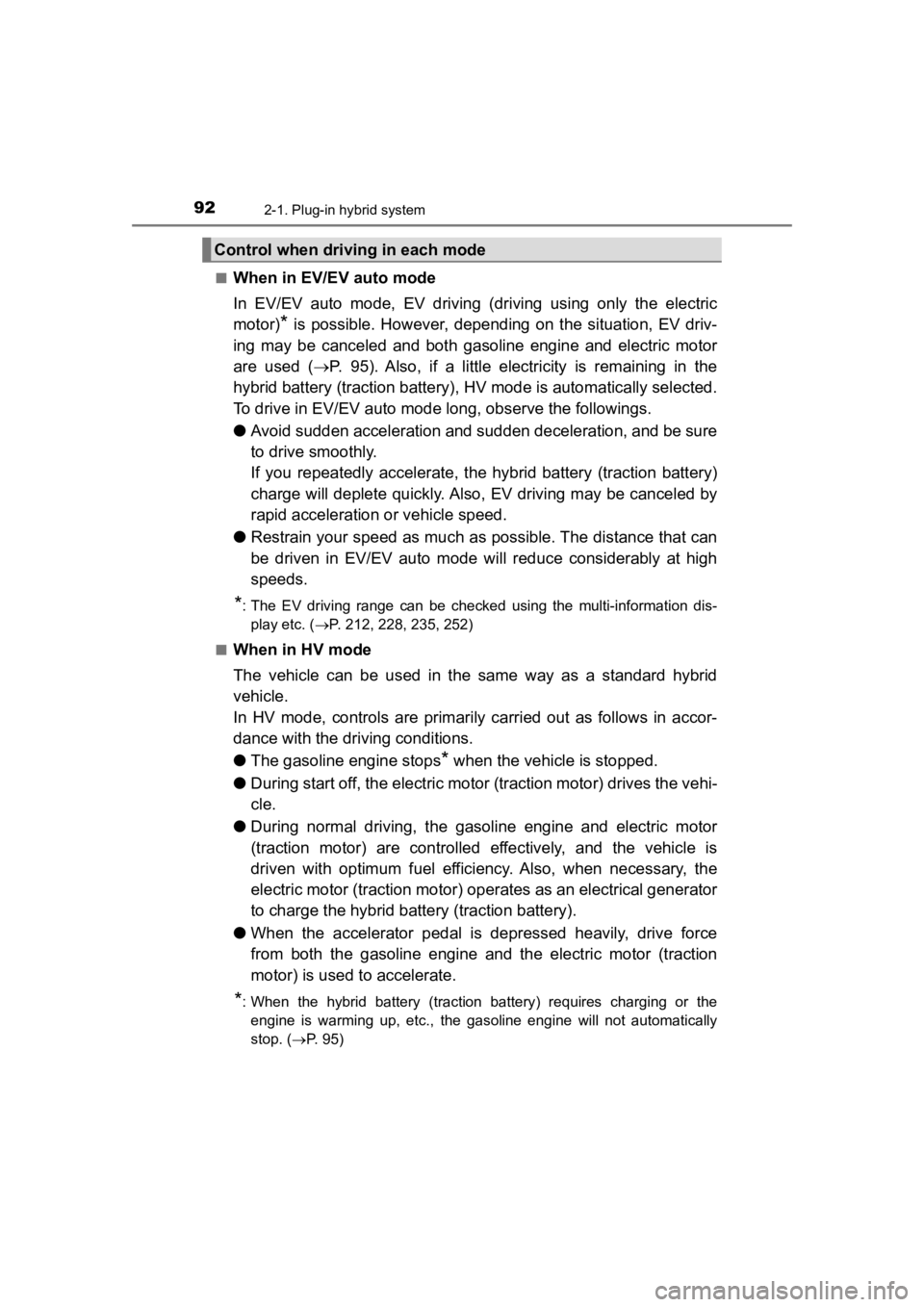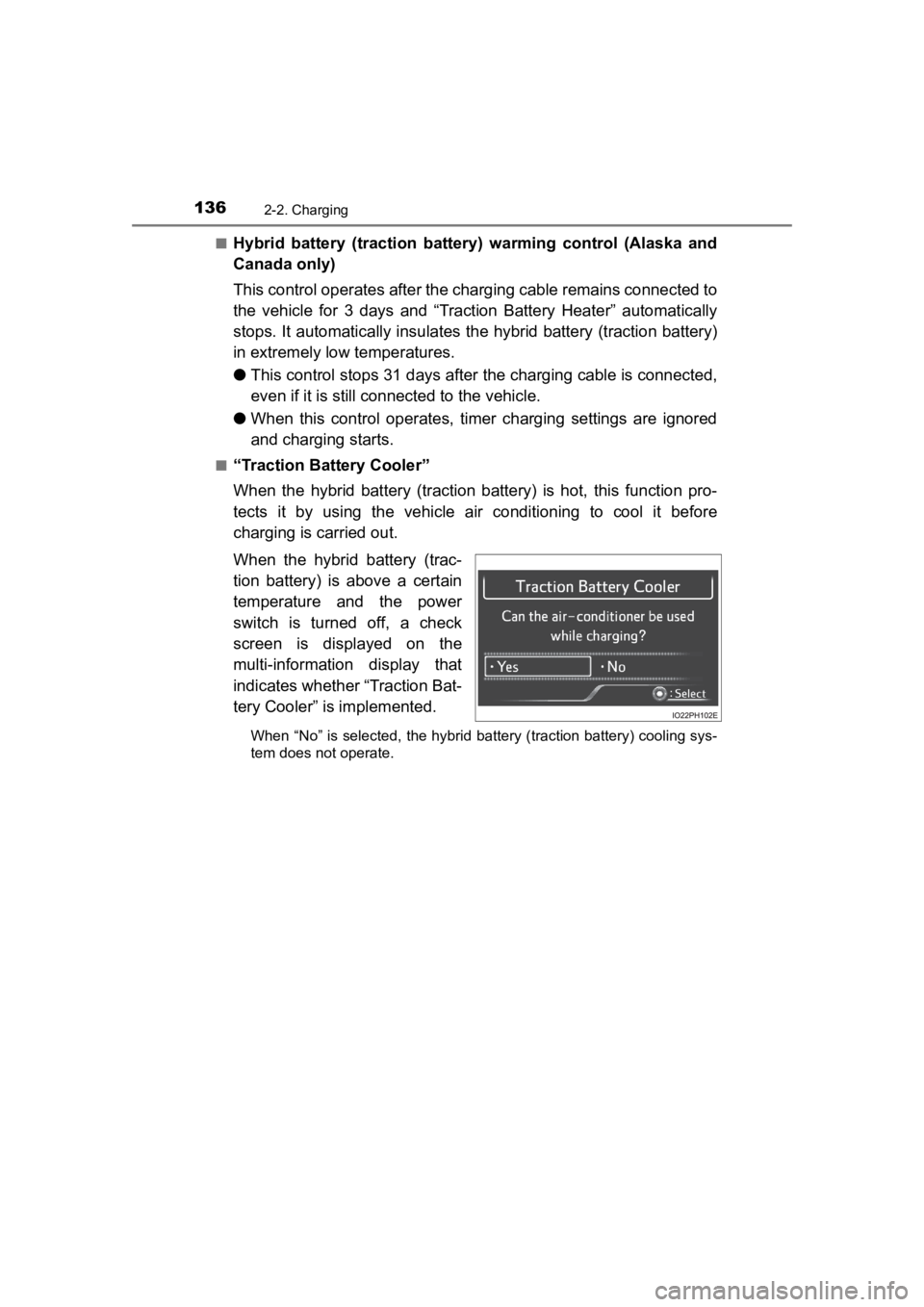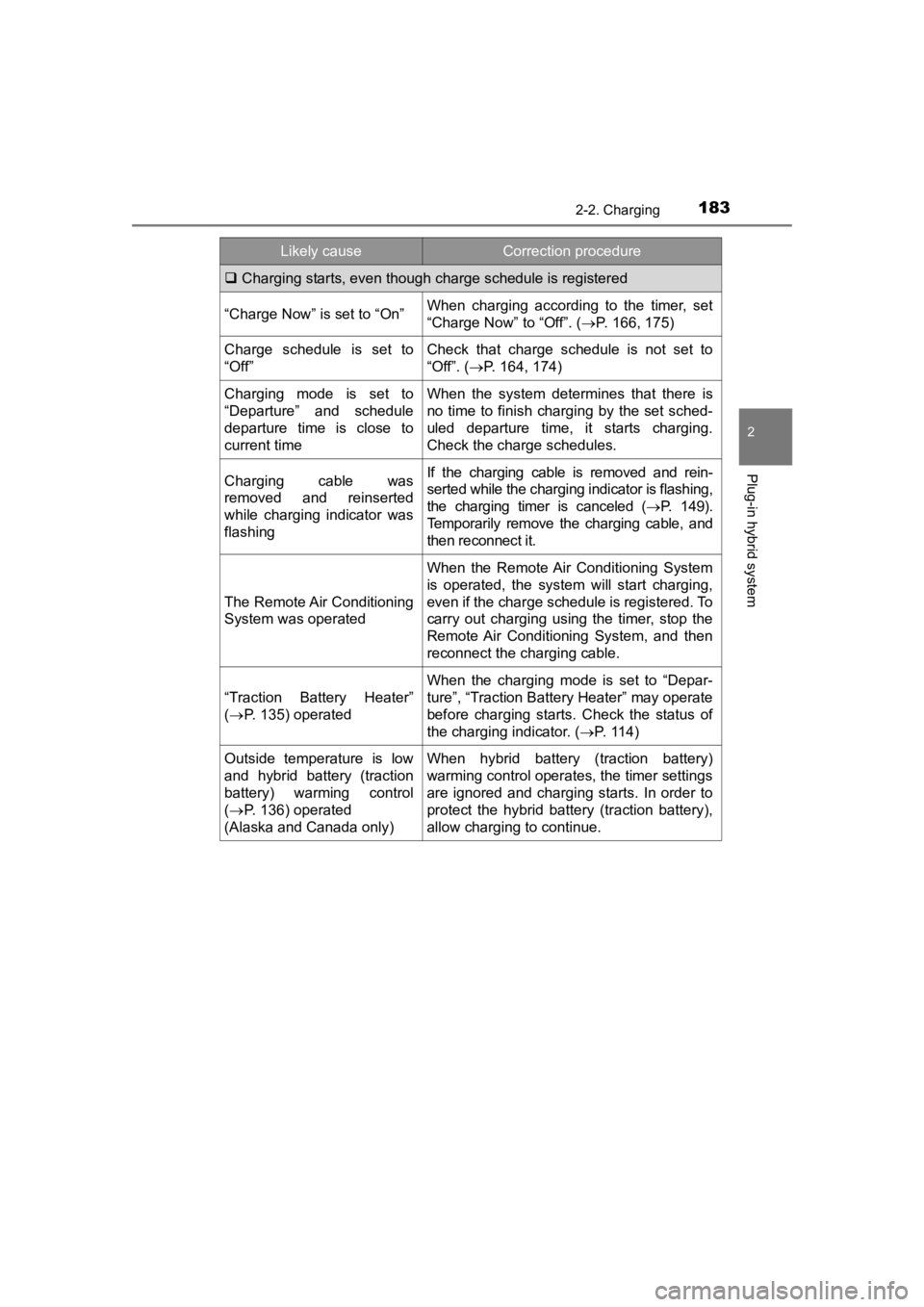2020 TOYOTA PRIUS PRIME traction control
[x] Cancel search: traction controlPage 12 of 792

12
PRIUS PRIME_OM_OM47C77U_(U)The SRS airbag and seat belt pretensioner devices in your Toyota contain
explosive chemicals. If the vehicle is scrapped with the airbags and seat belt
pretensioners left as they are, this may cause an accident such
as fire. Be
sure to have the systems of the SRS airbag and seat belt preten sioner
removed and disposed of by a qualified service shop or by your Toyota dealer
before you scrap your vehicle.
Special handling may apply,
See www.dtsc.ca.gov/hazardouswaste/perchlorate.
Your vehicle has components that may contain perchlorate. These compo-
nents may include airbag, seat belt pretensioners, and wireless remote con-
trol batteries.
Scrapping of your Toyota
Perchlorate Material
WARNING
■ General precautions while driving
Driving under the influence: Never drive your vehicle when under the influ-
ence of alcohol or drugs that have impaired your ability to operate your vehi-
cle. Alcohol and certain drugs delay reaction time, impair judg ment and
reduce coordination, which could lead to an accident that could result in
death or serious injury.
Defensive driving: Always drive defensively. Anticipate mistake s that other
drivers or pedestrians might make and be ready to avoid accidents.
Driver distraction: Always give your full attention to driving. Anything that
distracts the driver, such as adjusting controls, talking on a cellular phone or
reading can result in a collision with resulting death or serious injury to you,
your occupants or others.
■ General precaution regarding children’s safety
Never leave children unattended in the vehicle, and never allow children to
have or use the key.
Children may be able to start the vehicle or shift the vehicle into neutral.
There is also a danger that children may injure themselves by playing with
the windows, or other features of the vehicle. In addition, heat build-up or
extremely cold temperatures inside the vehicle can be fatal to children.
Page 86 of 792

86
PRIUS PRIME_OM_OM47C77U_(U)
2-1. Plug-in hybrid system
Plug-in hybrid system features
The illustration is an example for explanation and may differ from the
actual item.
Gasoline engine
Electric motor (traction motor)
The plug-in hybrid system is a system excellent in both econom-
ical efficiency of electric vehicles and practicality of hybrid vehi-
cles.
● EV driving can be performed using electricity charged from an
external power source.
*
●If the amount of electricity remaining in the hybrid battery (t raction
battery) becomes low, the vehicle is automatically controlled i n
such a way that it can be driven as a hybrid vehicle through the
joint use of the gasoline engine.
*: The EV driving range will vary in accordance with conditions s uch as
vehicle speed, the amount of charge remaining in the hybrid bat tery
(traction battery) and the usage of the air conditioning system. The gaso-
line engine may also be used simultaneously in accordance with driving
conditions.
1
2
Page 92 of 792

92
PRIUS PRIME_OM_OM47C77U_(U)
2-1. Plug-in hybrid system
■When in EV/EV auto mode
In EV/EV auto mode, EV driving (driving using only the electric
motor)
* is possible. However, depending on the situation, EV driv-
ing may be canceled and both gaso line engine and electric motor
are used ( P. 95). Also, if a little electricity is remaining in the
hybrid battery (traction battery), HV mode is automatically sel ected.
To drive in EV/EV auto mode l ong, observe the followings.
● Avoid sudden acceleration and sudden deceleration, and be sure
to drive smoothly.
If you repeatedly accelerate, the hybrid battery (traction batt ery)
charge will deplete quickly. Also , EV driving may be canceled by
rapid acceleration or vehicle speed.
● Restrain your speed as much as possible. The distance that can
be driven in EV/EV auto mode will reduce considerably at high
speeds.
*: The EV driving range can be checked using the multi-informatio n dis-
play etc. ( P. 212, 228, 235, 252)
■
When in HV mode
The vehicle can be used in the same way as a standard hybrid
vehicle.
In HV mode, controls are primarily carried out as follows in ac cor-
dance with the dr iving conditions.
● The gasoline engine stops
* when the vehicle is stopped.
● During start off, the electric motor (traction motor) drives the vehi-
cle.
● During normal driving, the gasoline engine and electric motor
(traction motor) are controlled effectively, and the vehicle is
driven with optimum fuel efficiency. Also, when necessary, the
electric motor (traction motor) operates as an electrical gener ator
to charge the hybrid battery (traction battery).
● When the accelerator pedal is depressed heavily, drive force
from both the gasoline engine and the electric motor (traction
motor) is used to accelerate.
*: When the hybrid battery (traction battery) requires charging or the
engine is warming up, etc., the gasoline engine will not automa tically
stop. ( P. 95)
Control when driving in each mode
Page 98 of 792

98
PRIUS PRIME_OM_OM47C77U_(U)
2-1. Plug-in hybrid system
Plug-in hybrid system precautions
The illustration is an example for explanation and may differ from the
actual item.
Take care when handling the hybrid system, as it contains a high
voltage system (about 600V at maximum) as well as parts that
become extremely hot when th e hybrid system is operating.
Obey the caution labels attached to the vehicle.
Caution label
Charging inlet
Service plug
Air conditioning compressor
Power control unit and DC/DC
converter Electric motor (traction motor)
High voltage c
ables (orange)
Battery charger
Hybrid battery (traction bat-
tery)1
2
3
4
5
6
7
8
9
Page 106 of 792

106
PRIUS PRIME_OM_OM47C77U_(U)
2-1. Plug-in hybrid system
◆Accelerator pedal/brake pedal operation
●Drive your vehicle smoothly. Avoid abrupt acceleration and
deceleration. Gradual accelerat ion and deceleration will make
more effective use of the electric motor (traction motor) witho ut
having to use gaso line engine power.
● Avoid repeated acceleration. Repeated acceleration consumes
hybrid battery (tracti on battery) power, resulting in poor fuel con-
sumption. Battery power can be restored by driving with the
accelerator pedal slightly released.
◆When braking
Make sure to operate the brakes gently and a timely manner. A
greater amount of electrical energy can be regenerated when slow-
ing down.
◆Delays
Repeated acceleration and deceleration, as well as long waits a t
traffic lights, will lead to high fuel and electricity consumption.
Check traffic reports before leav ing and avoid delays as much a s
possible. When driving in a traffic jam, gently release the brake
pedal to allow the vehicle to mov e forward slightly while avoiding
overuse of the accelerator pedal. Doing so can help control exces-
sive electricity and fuel consumption.
◆Highway driving
● Control and maintain the vehicle at a constant speed. Before
stopping at a toll booth or similar, allow plenty of time to re lease
the accelerator and gently apply the brakes. A greater amount o f
electrical energy can be regenerated when slowing down.
● Electricity consumption will in crease significantly when drivin g at
high speeds in EV mode. If there will be a long distance to the
next external charging point after leaving a freeway, it is rec om-
mended to drive in HV mode while on the freeway and change to
EV mode after leaving the freeway.
Page 112 of 792

112
PRIUS PRIME_OM_OM47C77U_(U)
2-2. Charging
■Closing the charging port lid
Close the charging port lid and
press the rear edge of the
charging port lid (the position
shown in the illustration).
Vehicles with smart lid & con-
nector locking system:
• When the doors are locked with the smart key system,
wireless remote control or
door lock switch, the charging
port lid is also locked.
(P. 279, 281)
• If the charging port lid is closed with the doors locked,
the charging port lid locks.
When the charging cable is con-
nected to the charging inlet, the
user is informed of the charging
status of the hybrid battery (trac-
tion battery) by the statuses of 3
indicators (turned off, illuminated
or flashing).
■During charging
Hybrid battery (traction battery) status indicator
Charging status of the
hybrid battery
(traction battery)Hybrid battery (traction battery) status indicator
About less than halfFlashesNot illuminatedNot illuminated
About more than halfIlluminatedFlashesNot illuminated
FullIlluminatedIlluminatedFlashes
123
Page 136 of 792

136
PRIUS PRIME_OM_OM47C77U_(U)
2-2. Charging
■Hybrid battery (traction battery) warming control (Alaska and
Canada only)
This control operates after the charging cable remains connected to
the vehicle for 3 days and “Traction Battery Heater” automatica lly
stops. It automatically insulates the hybrid battery (traction battery)
in extremely low temperatures.
● This control stops 31 days after the charging cable is connected,
even if it is still connected to t he vehicle.
● When this control operates, timer charging settings are ignored
and charging starts.
■“Traction Battery Cooler”
When the hybrid battery (traction battery) is hot, this functio n pro-
tects it by using the vehicle air conditioning to cool it befor e
charging is carried out.
When the hybrid battery (trac-
tion battery) is above a certain
temperature and the power
switch is turned off, a check
screen is displayed on the
multi-information display that
indicates whether “Traction Bat-
tery Cooler” is implemented.
When “No” is selected, the hybrid battery (traction battery) co oling sys-
tem does not operate.
Page 183 of 792

PRIUS PRIME_OM_OM47C77U_(U)
1832-2. Charging
2
Plug-in hybrid system
Charging starts, even though charge schedule is registered
“Charge Now” is set to “On”When charging according to the timer, set
“Charge Now” to “Off”. ( P. 166, 175)
Charge schedule is set to
“Off”Check that charge schedule is not set to
“Off”. (P. 164, 174)
Charging mode is set to
“Departure” and schedule
departure time is close to
current timeWhen the system determines that there is
no time to finish charging by the set sched-
uled departure time, it starts charging.
Check the charge schedules.
Charging cable was
removed and reinserted
while charging indicator was
flashingIf the charging cable is removed and rein-
serted while the charging indicator is flashing,
the charging timer is canceled ( P. 1 4 9 ) .
Temporarily remove the charging cable, and
then reconnect it.
The Remote Air Conditioning
System was operated
When the Remote Air Conditioning System
is operated, the system will start charging,
even if the charge schedule is registered. To
carry out charging using the timer, stop the
Remote Air Conditioning System, and then
reconnect the charging cable.
“Traction Battery Heater”
( P. 135) operated
When the charging mode is set to “Depar-
ture”, “Traction Battery Heater” may operate
before charging starts. Check the status of
the charging indicator. ( P. 114)
Outside temperature is low
and hybrid battery (traction
battery) warming control
( P. 136) operated
(Alaska and Canada only)When hybrid battery (traction battery)
warming control operates, the timer settings
are ignored and charging starts. In order to
protect the hybrid battery (traction battery),
allow charging to continue.
Likely causeCorrection procedure